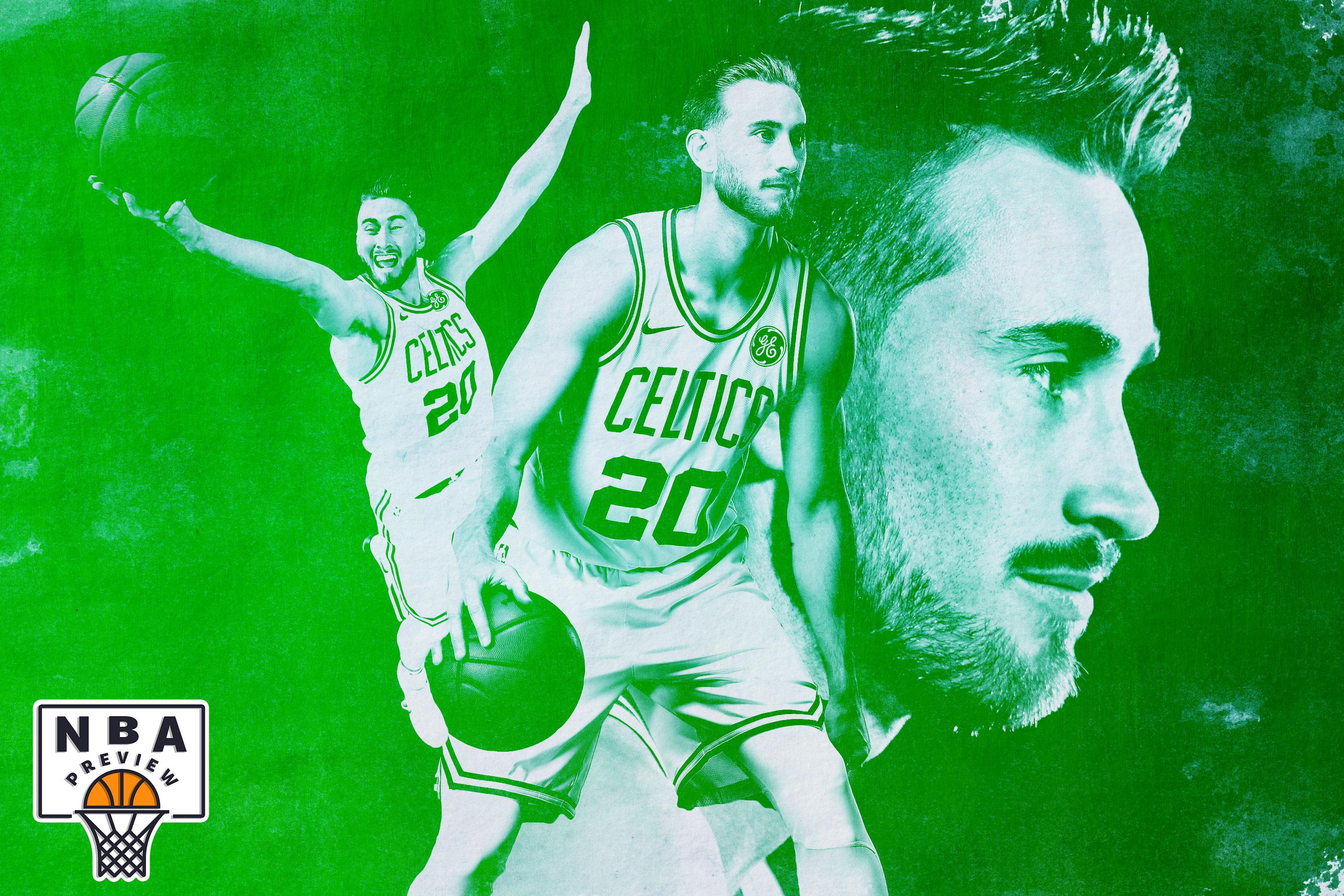
The following three plays take place during the first three minutes of the third quarter of a 2017 preseason game between the Celtics and Hornets.
Gordon Hayward slips a screen for Kyrie Irving, then the duo dances with the defense until Hayward moonwalks open for a 3. Hayward shot 39.2 percent on catch-and-shoot 3s the past four seasons; he can spot up and he can pick-and-pop. But he’s more than a shooter; sometimes, he’ll make a short roll toward the rim.
As the defense switches, Hayward rolls toward the rim and receives the ball, which activates him as a playmaker. From here, he can either continue to the rim or look for the open man. This time, the defense rotates and Hayward quickly finds Jayson Tatum open for another 3.
Next time around, the Celtics flipped the action.
This is what positionless basketball looks like on offense: Irving, a guard, screens for Hayward, a forward. Hayward is obviously no LeBron James, but the Cavaliers used their guard-forward pairing in similar ways, with Irving screening for LeBron to seek mismatches and force rotations that free open shooters. Tatum’s shot doesn’t fall in the play above, but that’s not important. After all, it’s a preseason game from almost one year ago. It’s just a reminder of the skill and versatility the Celtics were missing last season and what they have to look forward to with a healthy Hayward in 2018-19.
Though his decision to join Boston as a free agent in the summer of 2017 sent ripples around the league, Hayward has been on the periphery of the team’s rise to the top of the Eastern Conference. He broke his leg five minutes into the 2017-18 regular season. Before that, he was one of the most overlooked All-Stars in the league, playing for a small-market Jazz team that didn’t register on the national radar too often. Since Hayward signed in Boston, Tatum blossomed, Jaylen Brown kept improving, and the Celtics finished one game shy of the Finals. “You could argue they’re more experienced than I am, going to the Eastern Conference finals,” Hayward said at media day.
The Celtics roster that Hayward agreed to join doesn’t really exist anymore. Which makes you wonder: How will Hayward coexist with this loaded squad?
“He’s a guy that can play a lot of different roles,” Celtics head coach Brad Stevens said at media day. “He’ll have games this year where he scores the ball at a high level, and he’ll have games that he doesn’t but does other things to add value to winning.”
That versatility was what attracted the Celtics to Hayward in the first place and what should allow him to seamlessly adapt to their reshuffled roster this season. He scored a tremendous 1.09 points per possession in 2016-17, his last season with the Jazz, through a balanced diet on offense. He ranked in the 75th percentile or better in scoring efficiency with a long list of play types on Synergy Sports: pick-and-roll ballhandling, spot-up shooting, cutting, coming off screens, and in transition. Hayward is one of the main reasons the Jazz became an annual playoff contender. Now, Stevens will be able to use him in any role or lineup.
The Celtics could start the same five players as they did on opening night last season: Irving at point guard and Al Horford at center, with three switchy wings in Hayward, Tatum, and Brown in between them. Positionless basketball may be the new norm, but at a beefy 6-foot-8, Hayward is effectively the 4 in these lineups. Watch here how Hayward sits at the elbow in a “horns” set, a play where two big men traditionally are used to screen from the high post.
Hayward ends up taking a contested midrange dribble-jumper, which is a poor choice considering the amount of time left on the shot clock. But the shot doesn’t matter as much as how he’s used. Hayward, a “big” in this set, morphs into a wing as he sprints through Irving’s screen and into the dribble handoff from Horford. If that play is run again, it might end up with an open Irving 3 or a layup for Horford. If the handoff happens a few feet farther from the rim, Hayward could pull up from 3 instead of 2.
He provides Boston with more options than it had with Tatum, Brown, or Marcus Morris since Hayward is more experienced at executing a variety of plays. Later in the third quarter against the Hornets, Stevens called another mix-and-match set that featured Hayward setting a down screen for Horford.
After Hayward screens Dwight Howard, Horford jukes toward the rim to catch the defense’s attention and give Hayward time to backpedal into a 3. Inverted plays like this are becoming more normal in today’s NBA as more big men learn to shoot, but the Celtics could take it to the extreme. When these five shared the court during preseason, it seemed like Hayward was on a different area of the court every possession.
The Celtics won’t always play small ball with Horford at the 5. If the Celtics go big and put Aron Baynes in alongside Horford, then Hayward can slide to the 3. Or, if Stevens goes with a jumbo package with a smaller point guard like Irving or Terry Rozier, then Hayward can handle more playmaking responsibility. Hayward isn’t the sort of dynamic playmaker who will appear nightly on House of Highlights, but he makes smart reads and delivers the ball with precision.
Hayward can change gears to create space and throw darts across the court or bounce passes that glide straight into the hands of a rolling big. He’s always been an unselfish player who makes the extra pass. He didn’t enter the NBA with this much skill, but his ballhandling has gotten tighter and his footwork has gotten cleaner each season of his career. “Gordon’s ability to play as the primary ball handler will open up opportunities,” Stevens said. Those opportunities could include utilizing Irving as a screener or Hayward at the elbow, like in the previous plays. Or Hayward can create opportunities by attacking after grabbing a rebound or receiving an outlet pass.
The Jazz have played slowly during the Quin Snyder era; they ranked 30th in pace over Hayward’s last three seasons in Utah. It worked, but didn’t highlight Hayward as one of the NBA’s most lethal transition scorers. He logged 1.4 points per possession but on only 150 possessions, per Synergy. Hayward led the Jazz by a wide margin, but four Celtics—Brown, Tatum, Irving, and Rozier—logged more transition possessions last season. Boston finished 23rd in pace last season, but still logged considerably more fast-break possessions than Hayward’s teams did in Utah. Hayward should receive more chances to motor the ball up the floor, leading to more scoring and playmaking.
Hayward won’t always have the ball in his hands, of course. Irving is an All-NBA talent. Horford is one of the NBA’s premier passing bigs. Tatum is deserving of more shots, while Brown, Rozier, and others also need touches. But Hayward, a savvy off-ball player, can make it work.
Hayward tiptoes toward the baseline like he’s hunting rabbits, then turns on the jets to take advantage of the opening in the defense. You’ll find Hayward using an assortment of cuts, pushes, and nudges to break free of a defender. Hayward became a player who can be leaned on to get a bucket, but he first mastered off-ball execution; that’s why he’s so talented in getting open using screens or dribble handoffs. Hayward is a glue guy who became a star.
“I’ve always been a basketball player that has done a little bit of everything and done whatever the coach needs me to do,” Hayward said at media day. “Because of the talent that we have, [my role won’t] necessarily be the same every single game. Some days it might be for me to score. Some days it might be for me to play make. Some days might be for me to defend.” Indeed, in addition to what he can bring to the Celtics offense, Hayward’s combination of length, mobility, and rebounding ability only makes last season’s league-best defense even deeper.
Hayward adds to the supply of versatile wings and forwards. In Hayward, Tatum, Brown, Morris, and Semi Ojeleye, the Celtics have five players standing between 6-foot-7 and 6-foot-9 who can space the floor on offense and switch screens on defense. Factor in two versatile bigs—Horford and Daniel Theis—plus Marcus Smart at guard, and Stevens will have all sorts of options. Hayward isn’t a lockdown defender like Jimmy Butler, but he’s a pretty good one. You can say something similar about many areas of his game. But the breadth of his game makes up for any holes (which you have to squint to find to begin with). He isn’t an advanced post scorer like DeMar DeRozan, but he has basic moves and can pass. He’s not an elite isolation scorer like James Harden, but he can get you a bucket. He’s not an elite shooter like Klay Thompson, but he’ll catch fire. Few players check as many boxes.
There will of course be an adjustment period following virtually a full season away from the court. Hayward needs to regain his rhythm and adjust to a more broad role. But adapting is what he does. That’s what makes him perfect for the reloaded Celtics. They don’t need everything from Hayward all at once; he can provide what the team needs when it needs it.
